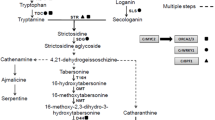Abstract
Leaves of Nicotiana tabacum L. cv. Xanthi necroticum plants form local necrotic lesions at the site of infection by tobacco mosaic virus. During the first seven days post-inoculation, endogenous levels of 1-aminocyclopropane-1-carboxylic acid (ACC) and N-malonyl-ACC increased in the lesion area. The time course of ACC accumulation coincided with an increase in the endogenous cyanide level which began within two days after inoculation. Concomitantly, the activity of β-cyanoalanine synthase, the main HCN detoxifying enzyme, decreased. Likewise, treatment of leaf discs of uninfected plants with ACC led to cyanide accumulation. Exogenously applied KCN caused necrotic spots on tobacco leaves very similar to the whitish centers of virus-induced local lesions. Possible implications of cyanide in cell death during TMV-induced lesion development are discussed.
Similar content being viewed by others
References
Abeles FB, Morgan PW and Saltveit ME (eds) (1992) Ethylene in Plant Biology. San Diego: Academic Press
Blumenthal SG, Hendrickson HR, Abrol YP and Conn EE (1968) Cyanide metabolism in higher plants. III. The biosynthesis of β-cyanoalanine. J Biol Chem 243: 5302–5307
Boller T (1991) Ethylene in pathogenesis and disease resistance. In: Mattoo AK and Suttle JC (eds) The Plant Hormone Ethylene, pp 293–331. Boca Raton: CRC Press
De Laat AMM and Van Loon LC (1981) Regulation of ethylene biosynthesis in virus-infected tobacco leaves. I. Determination of the role of methionine as the precursor of ethylene. Plant Physiol 68: 256–260
De Laat AMM and Van Loon LC (1983) The relationship between stimulated ethylene production and symptom expression in virus-infected tobacco leaves. Physiol Plant Pathol 22: 261–273
Grossmann K, Häuser C, Sauerbrey E, Fritsch HJ, Schmidt O and Jung J (1989) Plant growth retardants as inhibitors of ethylene production. J Plant Physiol 134: 538–543
Grossmann K and Kwiatkowski J (1993) Selective induction of ethylene and cyanide biosynthesis appears to be involved in the selectivity of the herbicide quinclorac between rice and barnyardgrass. J Plant Physiol 142: 457–466
Harborne JB (1973) The chlorophylls. In: Harborne JB (ed) Phytochemical Methods, pp 204–211. London: Chapman and Hall
Lambert JL, Ramasamy J and Paukstelis JV (1975) Stable reagents for the colorimetric determination of cyanide by modified König reactions. Anal Chem 47: 916–918
Lizada MCC and Yang SF (1979) A simple and sensitive assay for 1-aminocyclopropane-1-carboxylic acid. Anal Biochem 100: 140–145
Melchers G, Jockusch H and von Sengbusch P (1966) A tobacco mutant with a dominant allele for hypersensitivity against some TMV-strains. Phytopathol Z 55: 86–88
Solomanson LP (1981) Cyanide as a metabolic inhibitor. In: Vennesland B, Conn EE, Knowles CJ, Westley J and Wissing F (eds) Cyanide as Metabolic Inhibitor, pp 11–28. New York: Academic Press
Strange RN (1992) Resistance: the role of the hypersensitive response and phytoalexins. In: Ayres PG (ed) Pests and Pathogens: Plant Responses to Foliar Attack, pp 39–55. Oxford: BIOS Scientific Publishers
Takahashi WN (1956) Increasing the sensitivity of the locallesion method of virus assay. Phytopathology 46: 654–656
Van Loon LC (1977) Induction by 2-chloroethylphosphonic acid of viral-like lesions, associated proteins, and systemic resistance in tobacco. Virology 80: 417–420
White RF and Antoniw JF (1991) Virus-induced resistance responses in plants. Crit Rev Plant Sci 9: 443–455
Yang SF, Yip WK, Satho S, Miyazaki JH, Jiao X, Liu Y and Su LY (1988) Metabolic aspects of ethylene biosynthesis. In: Pharis SB and Rood SB (eds) Plant Growth Substances 1988, pp 291–299. Berlin: Springer-Verlag
Yip WK and Yang SF (1988) Cyanide metabolism in relation to ethylene production in plant tissue. Plant Physiol 88: 473–476
Author information
Authors and Affiliations
Rights and permissions
About this article
Cite this article
Siefert, F., Kwiatkowski, J., Sarkar, S. et al. Changes in endogenous cyanide and 1-aminocyclopropane-1-carboxylic acid levels during the hypersensitive response of tobacco mosaic virus-infected tobacco leaves. Plant Growth Regul 17, 109–113 (1995). https://doi.org/10.1007/BF00024169
Received:
Accepted:
Issue Date:
DOI: https://doi.org/10.1007/BF00024169




